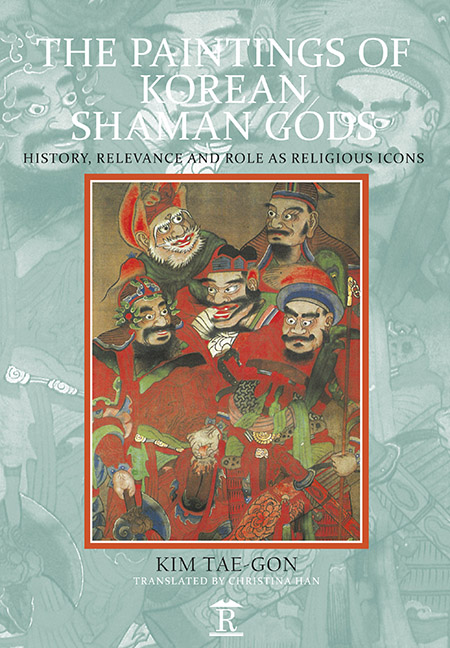Book contents
- Frontmatter
- Contents
- Translator’s Preface
- List of Figures
- List of Plates
- Introduction Visions, Images, Performance: Understanding Korean Shaman Art
- Chapter 1 Paintings Of Korean Shaman Gods
- Chapter 2 The Shaman God Painting As An Icon And Its Artistic Qualities
- Images Of Korean Shaman Gods
- Glossary of Terms
Chapter 2 - The Shaman God Painting As An Icon And Its Artistic Qualities
Published online by Cambridge University Press: 30 April 2022
- Frontmatter
- Contents
- Translator’s Preface
- List of Figures
- List of Plates
- Introduction Visions, Images, Performance: Understanding Korean Shaman Art
- Chapter 1 Paintings Of Korean Shaman Gods
- Chapter 2 The Shaman God Painting As An Icon And Its Artistic Qualities
- Images Of Korean Shaman Gods
- Glossary of Terms
Summary
GENERAL REFLECTIONS ON SHAMANISM
Despite the worldwide scholarly interest in shamanism in the recent past, there is a need to further explore a constructive and systematic approach to the study of the subject. Shamanism is not to be regarded as superstition, but as a system of powerful and infuluential religious customs that have shaped the world's civilizations before and since the Axial Age. Shamanism had a significant infuluence on the later development of the so-called high religions, including Buddhism, Confucianism, Zoroastrianism, and Christianity.
In Korean history, for example, the period prior to the introduction of Buddhism and Confucianism in the sixth century CE can be characterized as the age of shamanism. The shamanistic era roughly coincided with the period of ancient tombs (ca. 2000 BCE-668 CE). Textual sources plainly indicate that shamanism was venerated as the state religion during the Samhan (first century BCE to fourth century CE), and Three Kingdoms (57 BCE-668 CE) periods. The clearest evidence of shaman worship during the latter period is found in the Samguk yusa (Memorabilia of the Three Kingdoms), which expounds that the rulers of Silla, one of the Three Kingdoms, were shaman-kings. Chachaung the Silla expression for “shaman,” is even found within the name of the second Silla king Namhae chachaung (d. 24). In fact, a study conducted by Yi Neung-hwa (1869–1943) shows that, during Korea's prehistoric times, all priestly figures (including shamans) who worshipped the Heavenly God were called Dangun (Sandalwood King), which was also the name of the legendary founder of Go-Joseon, the first Korean kingdom (ca. 2333-108 BCE).
Yi traces the inception of Korean shamanism to 2400 BCE, beginning with the arrival in the Korean peninsula of Hwanung, the Son of Heaven and the father of Dangun. This reveals a remarkably long history of Korean shamanism, especially when compared to the short 800-yearlong and 500-year-long histories of Buddhism and Confucianism, respectively, in Korea. In fact, as the early modern intellectual Sin Chae-ho (1880–1936) once asserted, overlooking the history of shamanism would be like denying the essence of Korean culture.
It would therefore be reasonable to characterize Korean art, particularly ancient tomb art, prior to the introduction of Buddhism as a form of shaman art.
- Type
- Chapter
- Information
- The Paintings of Korean Shaman GodsHistory, Relevance and Role as Religious Icons, pp. 45 - 72Publisher: Amsterdam University PressPrint publication year: 2018



